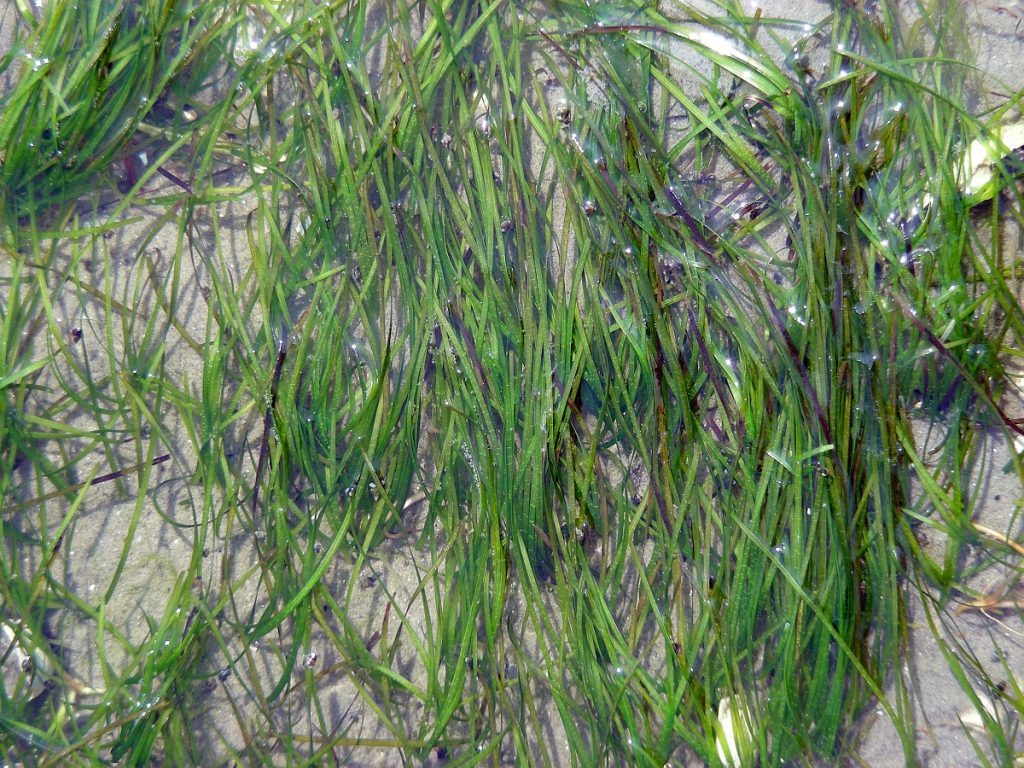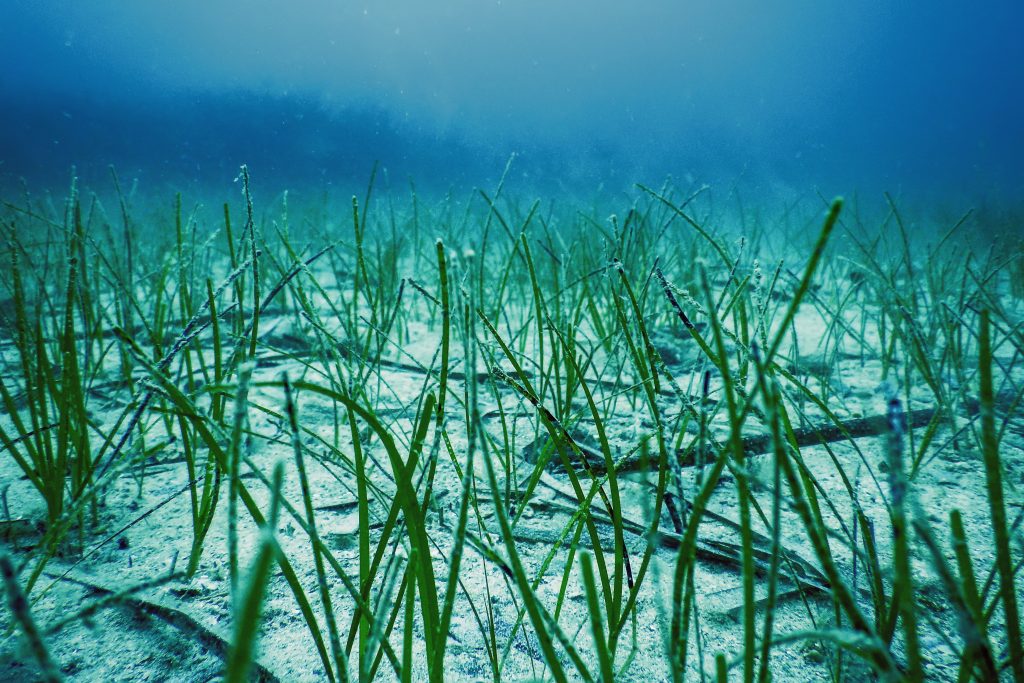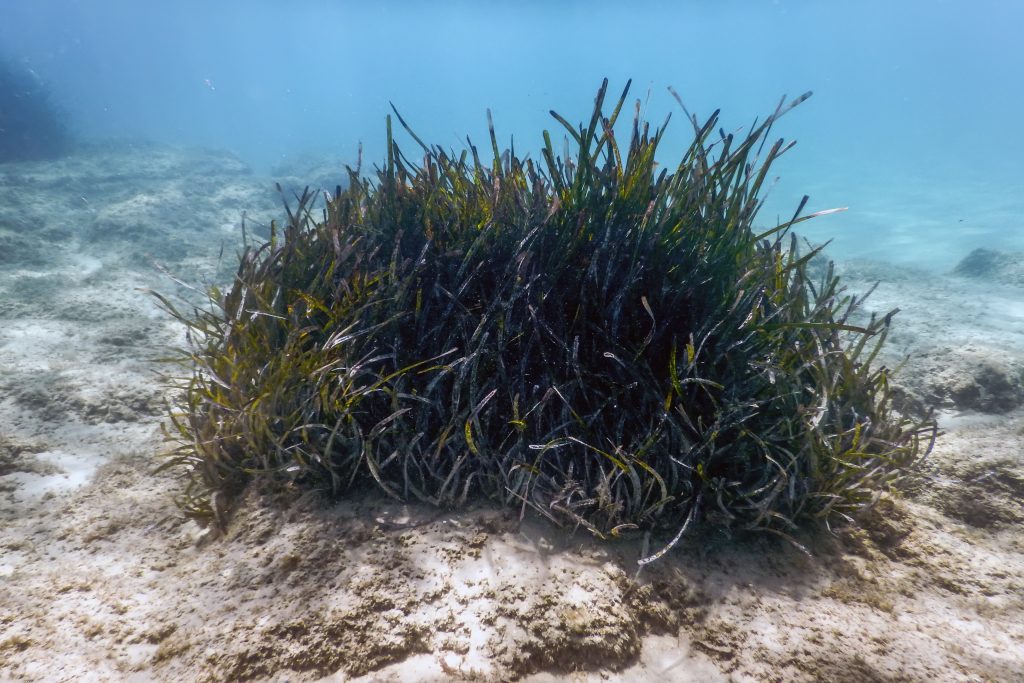
Seagrass bedsSpecies
Seagrass flowering marine plant species of the Karin Sea: Zostera marina, Zostra noltei, Cymodocea nodosa

Seagrasses are a group of true plants that have fully adapted to life in the sea. Unlike algae, seaweeds have a habitus on which the root, tree, leaf, and flower are clearly distinguished (Hogarth, 2007). They belong to the group of angiosperms (Nikolić, 2013). The habitat of seagrass is specific for the looseness and instability of the substrate, salinity and the small amount of light required for photosynthesis (it can be found at depths of up to 90 meters). The rhizomes of seagrass plants have multiple roots that attach them to the seabed, forming underwater meadows. They have the role of retaining and reducing sediment mobility and water flow, making the environment conducive to the development of other marine areas of organisms (Hemming and Duarte, 2000). The flowers, if any, are small and bisexual. About 50-60% of marine flower biomass is found in the rhizome and root (Hogarth, 2007).
Anthropogenic influences destroy seagrass beds and degrade the entire coastal ecosystem. Currently, great efforts are being made to rehabilitate endangered seagrass habitats in certain parts of the world by controlling and improving water quality, completely relocating meadows to other locations, restricting navigation, fishing and aquaculture, and legal and environmental protection of existing and endangered habitats.
The Bern Convention on the Conservation of European Wildlife and Natural Habitats, adopted in 1979 in the Mediterranean Basin, did not initially include the protection of any species of marine flora. This Convention was amended in 1996 and then 3 out of 5 species of sea flowers in the Mediterranean (Cymodocea nodosa, Posidonia oceanica and Zostera marina) were included in its protection (Jović, M., 2013).
In the area of the Novigrad and Karin Seas, seagrass species are widespread: dwarf eelgrass (Zostera noltii), eelgrass (Zostera marina) and little Neptune grass (Cymodocea nodosa). Of the algae present, it is important to mention the species brown alga (Fuscus virsoides), which is an endemic species for the Adriatic Sea, and the species from the genus Cystoseira. All of the above species belong to strictly protected species (Garibović, 2011; Kruschel et al., 2011; Schultz et al., 2009; Jolić, 2014).
Residential program

Zostera noltii
Dwarf eelgrass
Zostera noltii or ” dwarf eelgrass “, voga or small feathers is a flowering plant that grows in shallow lagoons, and can often be found on the shore during high tide. The leaves are light to dark green in color, very narrow, and 5 to 30 centimeters long.
The flowers are inconspicuous, without flowers; many flowers are gathered in a two-row spike wrapped in a leaf-shaped sheath. The individual flower is made up of one anther and one pistil, which is pollinated in the sea by filamentous pollen. The leaves come 2-5 per shoot, and from the axil (not the uppermost) develops a flower stalk or colorless. The yield is green, 1.5-2 mm long and has one smooth, ellipsoidal, white seed.(Croatian Encyclopedia, 2021).
Zostera noltii is not resistant to water turbulence (increased wave hydrodynamics) turbidity, blurred or pollution, so it inhabits clean shallow salt water in calm lagoons or estuaries of rivers, muddy bottoms, but can also live in the area of tides. It has a role like other seaweeds, especially in water purification and substrate stabilization. It also provides refuge to many sea animals but is food for birds and other sea herbivores.
Young leaves develop in spring, and old ones die in autumn, and during the winter they survive only with rice buried in the substrate. All parts of the plant can float, and if it separates from the soil and fragments and is blown up by water, then a new plant can grow from fragments of shoots or rhizomes, if the broken part has found a fertile,favorable substrate. The yield can survive the digestion process of waterfowl and can be transported over long distances.
The ecological value of this plant (as well as others) is great and we must preserve it in order to maintain the vitality and biodiversity of our sea, so any pollution and devastation of habitats (due to individual and current financial gain) is a huge loss for future generations.

Zostera marina
Eelgrass
The seagrass Zostera marina- eelgrass, sea silk is also called: fringe, sea fringe, feathers, small aliga, growth, voga.This species is special because it can withstand a short time out of the water. The name “zostera” comes from cramp. zoster = belt, belt, ‘military belt’ (refers to the appearance of the leaves), and the epithet of the type ‘marina’ from the Latin marina = marine (habitat).
It is an underwater, marine, monoecious perennial with a creeping rhizome (2-6 mm thick, initially whitish-green and later darker brown) that has internodes 5-40 mm long, and there are roots on each rhizome node (2 or more ) up to 20 cm long and only 0.2-1 mm thick (they have root hairs). At the nodule, several leaves develop from the axils, from which new shoots emerge, either floral or colorless. Each shoot has a pair of leaves and the flowering plant develops a flower stalk up to 80 (-150) cm high. The leaves of the shoots are linear, while the leaves of colorless shoots are 20-50 (-120) cm x (2-) 5-12 mm, dark green, the tip is rounded and often mucronate (ie with a small spike) and the entire edge, and those on the flower the shoots are somewhat narrower.
When the fruitage ripen, the flower stalk separates from the parent plant and floats freely, thus spreading the ripe fruit in the hope that it will germinate into a new plant on favorable soil.
It tolerates slightly lower temperatures, slightly lower salt concentrations (compared to Posidonia), so it also tolerates brackish water, and inhabits both sandy and muddy bottoms from the area of tides to a few meters depth. It also oxygenates (produces oxygen, sea lungs) the sea, stabilizes the soil and reduces the impact of waves on the shore. Northern European peoples used this plant as a cover for houses, filled mattresses, fertilized the soil, some others ate rhizomes, fed poultry, however due to the exceptional benefit to living creatures of the sea, it is best to preserve and protect each of its habitats. It is remarkable as a hiding place and feeding ground for both herbivorous fish and predators (in a small site of sea silk, scientists have listed about 300 marine organisms associated with it. (Source: https://upwikihr.top/wiki/Zostera_marina)

Cymodocea nodosa
Little Neptune grass
The name ˝cymodocea˝ comes from the name of a Nereid, little Neptune grass , a sea nymph, called Cymodoce (basically Greek kyma = wavyness and Greek dechomai = greeting, as ˝ greeting waves˝), while the word ˝nodosa˝ comes from lat nodus = knot, knot or knot on a tree, bump.
Cymodocea nodosa – knotty sea fringe, golden silk, small aliga is a sea flower, dioecious, with a creeping, thin rhizome, reddish in color, branched roots. The leaves come 2-7 together on a shorter shoot, and on the nodes of the (vertical) rhizome there are annular scars from fallen leaves. he leaves are linear, up to 40 cm x 4 mm, the tip is round-obtuse, have 7-9 veins and towards the top are prickly-toothed, dark green. The trees develop parallel to the seabed, often covered with sediment, 3-4 mm thick, flexible and smooth. Densely formed “knots” are characteristic on the stem. The root is only a few millimeters thick.
Generally cymodocea reproduces vegetatively and by rapid expansion of the horizontal rhizome, growing a few meters per year in length.
The habitat is combined sandy – muddy with organic remains; from the sea surface to a depth of 10 m. In some places it forms underwater seagrass beads together with the species Zostera noltaei. It tolerates a certain amount of organic load.
It tolerates pollution and light reduction quite well and suppresses posidonia with rapid regeneration and growth of rhizomes. It is a plant that still loves clean sea and lots of light and temp. + 10 ° C to + 30 ° C and the soil sandy-muddy shallower areas. It is more resistant to hydrodynamic influences than posidonia. (Source:http://zastitamora.net/podmorje/morske-vrste/angiospermae-morske-cvjetnice/cymodocea-nodosa/).
Like other aquatic flowering plants, it is an extremely important element of sea health.
International Public Call for Artists and Art Collectives "ON ACCEPTING THE UNDESIRABLE"

Submit your application before November 15th, 2022. or inform your friends whose idea the jury will reward with a residency and a money reward, and the production of this important artistic intervention.


